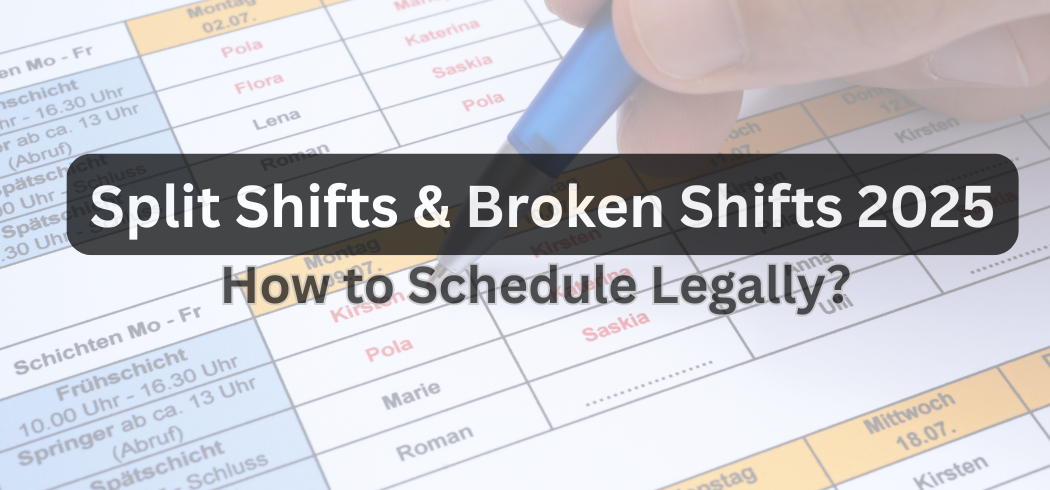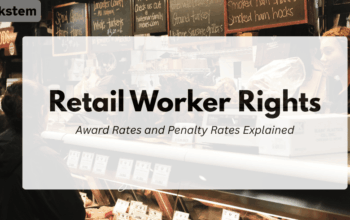In the hospitality industry, managing employee schedules can be complex, especially when it comes to split shifts and broken shifts. Understanding the legal implications and requirements in New South Wales (NSW), Victoria (VIC), and Queensland (QLD) is essential for maintaining compliant operations. This article will explore split shift rules, broken shift pay calculations, common underpayment scenarios, and important legal formulas to help you schedule your workforce properly in 2025.
What Are Split Shifts and Broken Shifts?
A split shift occurs when an employee’s work schedule is divided into two or more segments with a significant break between them. For instance, an employee may work from 10 AM to 2 PM, take a break, and then resume work from 5 PM to 9 PM.
A broken shift refers to a scenario where an employee’s working hours are interrupted by an unpaid break, creating a situation where the actual hours worked are broken up into non-contiguous segments throughout the day.
Why Are Split and Broken Shifts Important?
In the hospitality industry, split and broken shifts allow businesses to manage peak periods effectively, aligning staffing levels with customer demand. However, understanding the legal ramifications is critical to avoid underpayment and ensure compliance with local laws.
Who Is Affected by Split Shift Rules in Hospitality?
Employees working within the hospitality sector, including those under the Hospitality Industry General Award (HIGA), are particularly affected. Employers must adhere to the split shift rules outlined in the award to ensure fair compensation.
How to Calculate Broken Shift Pay?
Calculating pay for broken shifts involves the following steps:
- Identify the Total Hours Worked: Add up all the hours worked by the employee on that day.
- Determine Minimum Pay Rates: Refer to the relevant awards for minimum pay rates applicable for each hour worked.
- Calculate Break Duration: Compute the duration of the unpaid break. This should be taken into account for remuneration.
- Apply Legal Formulas: Use the specific formulas provided in the HIGA or relevant awards to ensure compliance and proper pay calculation.
Example Calculation:
If an employee worked two segments (5 hours in total) with a 2-hour unpaid break:
- Total hours worked: 5 hours
- Pay Rate: $25 per hour
- Total Pay = Total hours worked × Pay Rate = 5 hours × $25 = $125
How Workstem Helps Hospitality Industry Businesses
Simplify award interpretation and payroll processing with Workstem, the all-in-one workforce management & payroll software designed for every industry. Our system supports 122+ modern awards & 34 EAs, including the Hospitality Industry Award 2025, and keeps you up-to-date with changes in wage rates, penalty rates, and overtime rules.
Managing payroll under the Hospitality Industry Award 2025 can be complex. Workstem’s workforce management software ensures:
- Accurate award interpretation
- Automated penalty rates & overtime calculations
- Compliant payslips & record-keeping
- Seamless integrations with Xero, NetSuite, and more
Choose from our Standard or Advanced plan to suit your business needs, and stay Fair Work compliant with confidence.
Book a free demo with our payroll experts and experience how Workstem can streamline your payroll and workforce operations.
FAQs About the Hospitality Industry Award 2025
Q1: What is the Hospitality Industry Award 2025?
A1: The Hospitality Industry (General) Award 2025 (MA000009) sets minimum pay rates, penalty rates, and employment conditions for workers in hotels, restaurants, cafés, pubs, and clubs across Australia. It’s updated annually by the Fair Work Commission.
Q2: What are the key changes in the 2025 Award?
A2: Minimum wage increase: ~3.5% (projected) for full-time, part-time, and casual employees;penalty rates: Unchanged for weekends/public holidays, but base rates rise;casual loading: Remains at 25%.
Q3: Does the Award apply to casual workers?
A3: Yes. Casual employees receive: base rate + 25% loading (e.g., $24.05 + $6.01 = $30.06/hour); additional penalty rates for weekends/nights.
Q4: Are breaks and overtime included?
A4: Breaks: 10-minute paid rest breaks per 4-hour shift; overtime: Paid after 38 hours/week (full-time) or 10 hours/day.
Q5: Can Workstem help with casual employee management?
A5: Absolutely. Workstem supports casual loading, dynamic rosters, and real-time tracking to ensure casual workers are paid correctly and fairly under the award.
Q6: Is Workstem compliant with Fair Work and STP2?
A6: Yes, Workstem is fully compliant with Fair Work obligations and Single Touch Payroll Phase 2 (STP2), ensuring seamless reporting to the ATO.
Read More:
Hospitality Industry (General) Award Guide [MA000009]
Updated Hospitality Award Rates: What You Need to Know
Restaurant Award vs Hospitality Award: What’s the Difference?








